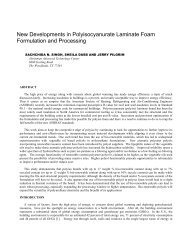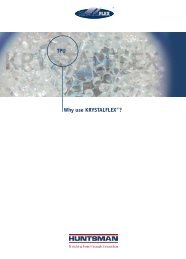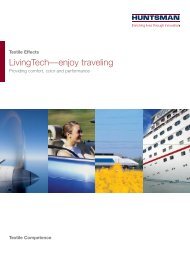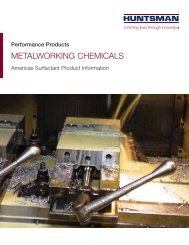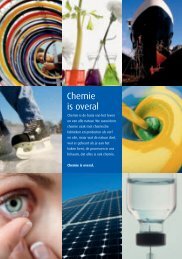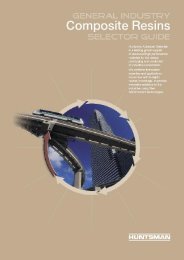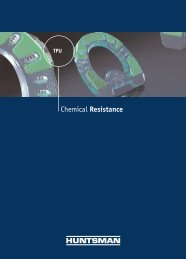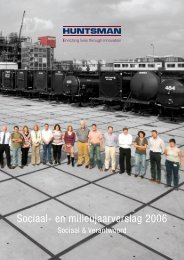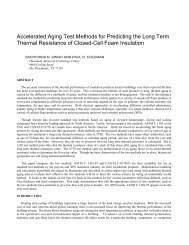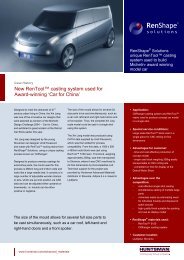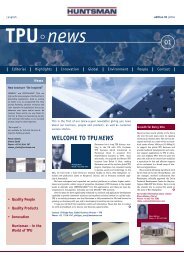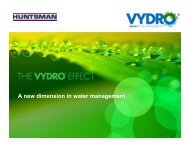CFD Modeling of the Closed Injection Wet-Out Process For Pultrusion
CFD Modeling of the Closed Injection Wet-Out Process For Pultrusion
CFD Modeling of the Closed Injection Wet-Out Process For Pultrusion
Create successful ePaper yourself
Turn your PDF publications into a flip-book with our unique Google optimized e-Paper software.
The momentum sources, S, defining<br />
<strong>the</strong> moving porous medium are<br />
S u U<br />
K<br />
K, and U are <strong>the</strong> permeability tensor,<br />
porosity and velocity <strong>of</strong> <strong>the</strong> fiber<br />
bundle. The geometry <strong>of</strong> <strong>the</strong> injection<br />
box is shown in Figure 2. This<br />
approach is similar to <strong>the</strong> model<br />
demonstrated by Jeswani et al. [Ref. 4]<br />
The approach is a phenomenological<br />
one with <strong>the</strong> main assumption being<br />
that <strong>the</strong> surface tension effects are not<br />
important or are captured in <strong>the</strong><br />
permeability tensor. The<br />
reinforcements are initially dry and <strong>the</strong><br />
resin must penetrate <strong>the</strong> fiber bundles.<br />
Capillary forces <strong>of</strong> attraction and<br />
repulsion act at <strong>the</strong> flow front. These<br />
forces, which depend on <strong>the</strong> surface<br />
tension <strong>of</strong> <strong>the</strong> resin and on its ability to<br />
adhere to <strong>the</strong> surface <strong>of</strong> <strong>the</strong> fibers, have<br />
an effect <strong>of</strong> increasing or decreasing<br />
<strong>the</strong> effective pressure at <strong>the</strong> resin front.<br />
However, <strong>the</strong>y are assumed to be<br />
sufficiently small to be neglected by<br />
<strong>the</strong> model. This assumption can be<br />
checked with micro-scale modeling <strong>of</strong><br />
air-resin interface flow in fiber<br />
bundles.<br />
A fur<strong>the</strong>r assumption in <strong>the</strong> model is<br />
that degree <strong>of</strong> conversion and hence<br />
build-up <strong>of</strong> viscosity is small and,<br />
hence, can be ignored in <strong>the</strong> injection<br />
box region. It is also assumed that<br />
<strong>the</strong>re is no shear rate dependence <strong>of</strong><br />
viscosity. These complexities can be<br />
added to <strong>the</strong> model without great<br />
difficulty.<br />
Porosity and Fiber Volume Fraction<br />
The porosity <strong>of</strong> <strong>the</strong> fiber bundle varies<br />
with axial distance in <strong>the</strong> model<br />
1 Vf ( z)<br />
hence, <strong>the</strong> stream wise and transverse<br />
permeability throughout <strong>the</strong> injection<br />
is not constant. An example <strong>of</strong> porosity<br />
variation throughout <strong>the</strong> injection box<br />
is shown in Figure 3.<br />
Permeability Model<br />
The Gebart permeability model [Ref.<br />
5] with a hexagonal fiber arrangement<br />
was chosen to model <strong>the</strong> permeability<br />
in both <strong>the</strong> axial and transverse fiber<br />
directions. The model is particularly<br />
suited to pultrusion processes as <strong>the</strong><br />
fibers are unidirectional. In <strong>the</strong> axial<br />
direction, <strong>the</strong> permeability is defined<br />
by<br />
K<br />
z<br />
2D<br />
2 3<br />
f<br />
2<br />
c<br />
(1 )<br />
where Df is <strong>the</strong> effective fiber diameter<br />
and c a model constant. The<br />
permeability in <strong>the</strong> transverse direction<br />
is<br />
K K<br />
x y<br />
C D<br />
V<br />
1<br />
2<br />
f f ,max<br />
1<br />
4 (1 )<br />
where Vf,max is <strong>the</strong> maximum volume<br />
fraction <strong>of</strong> fibers and C1 a model<br />
constant. Pr<strong>of</strong>iles <strong>of</strong> stream wise and<br />
transverse permeability are shown in<br />
Figure 4.<br />
Boundary Conditions<br />
Where <strong>the</strong> fiber reinforcement enters<br />
<strong>the</strong> injection box, <strong>the</strong> pressure is set to<br />
atmospheric pressure and a positive<br />
pressure is set at <strong>the</strong> injection port. At<br />
<strong>the</strong> exit <strong>of</strong> <strong>the</strong> computational domain, a<br />
small distance into <strong>the</strong> die, <strong>the</strong> axial<br />
velocity is set to <strong>the</strong> porosity times <strong>the</strong><br />
pull speed.<br />
5<br />
2



